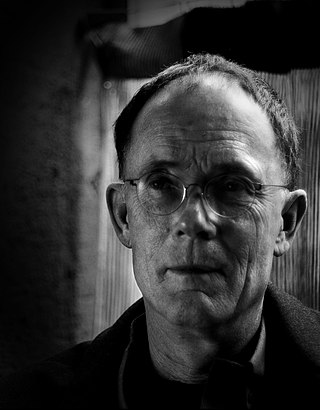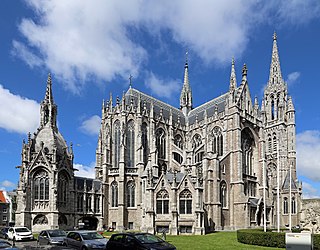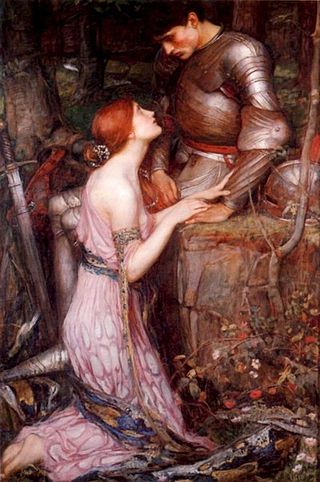
Cyberpunk is a subgenre of science fiction in a dystopian futuristic setting that tends to focus on a "combination of lowlife and high tech", featuring futuristic technological and scientific achievements, such as artificial intelligence and cyberware, juxtaposed with societal collapse, dystopia or decay. Much of cyberpunk is rooted in the New Wave science fiction movement of the 1960s and 1970s, when writers like Philip K. Dick, Michael Moorcock, Roger Zelazny, John Brunner, J. G. Ballard, Philip José Farmer and Harlan Ellison examined the impact of drug culture, technology, and the sexual revolution while avoiding the utopian tendencies of earlier science fiction.

William Ford Gibson is an American-Canadian speculative fiction writer and essayist widely credited with pioneering the science fiction subgenre known as cyberpunk. Beginning his writing career in the late 1970s, his early works were noir, near-future stories that explored the effects of technology, cybernetics, and computer networks on humans—a "combination of lowlife and high tech"—and helped to create an iconography for the information age before the ubiquity of the Internet in the 1990s. Gibson coined the term "cyberspace" for "widespread, interconnected digital technology" in his short story "Burning Chrome" (1982), and later popularized the concept in his acclaimed debut novel Neuromancer (1984). These early works of Gibson's have been credited with "renovating" science fiction literature in the 1980s.

Retrofuturism is a movement in the creative arts showing the influence of depictions of the future produced in an earlier era. If futurism is sometimes called a "science" bent on anticipating what will come, retrofuturism is the remembering of that anticipation. Characterized by a blend of old-fashioned "retro styles" with futuristic technology, retrofuturism explores the themes of tension between past and future, and between the alienating and empowering effects of technology. Primarily reflected in artistic creations and modified technologies that realize the imagined artifacts of its parallel reality, retrofuturism can be seen as "an animating perspective on the world".

Amazing Stories is an American science fiction magazine launched in April 1926 by Hugo Gernsback's Experimenter Publishing. It was the first magazine devoted solely to science fiction. Science fiction stories had made regular appearances in other magazines, including some published by Gernsback, but Amazing helped define and launch a new genre of pulp fiction.

Gothic Revival is an architectural movement that after a gradual build-up beginning in the second half of the 17th century became a widespread movement in the first half of the 19th century, mostly in England. Increasingly serious and learned admirers sought to revive medieval Gothic architecture, intending to complement or even supersede the neoclassical styles prevalent at the time. Gothic Revival draws upon features of medieval examples, including decorative patterns, finials, lancet windows, and hood moulds. By the middle of the 19th century, Gothic Revival had become the preeminent architectural style in the Western world, only to begin to fall out of fashion in the 1880s and early 1890s.

Googie architecture is a type of futurist architecture influenced by car culture, jets, the Atomic Age and the Space Age. It originated in Southern California from the Streamline Moderne architecture of the 1930s, and was popular in the United States from roughly 1945 to the early 1970s.

Rose window is often used as a generic term applied to a circular window, but is especially used for those found in Gothic cathedrals and churches. The windows are divided into segments by stone mullions and tracery. The term rose window was not used before the 17th century and comes from the English flower name rose.
Populuxe was a consumer culture and aesthetic in the United States popular in the 1950s and 1960s. The term populuxe is a portmanteau of popular and luxury.

The culture of Europe is diverse, and rooted in its art, architecture, traditions, cuisines, music, folklore, embroidery, film, literature, economics, philosophy and religious customs.
Since the advent of the cyberpunk genre, a number of cyberpunk derivatives have become recognized in their own right as distinct subgenres in speculative fiction, especially in science fiction. Rather than necessarily sharing the digitally and mechanically focused setting of cyberpunk, these derivatives can display other futuristic, or even retrofuturistic, qualities that are drawn from or analogous to cyberpunk: a world built on one particular technology that is extrapolated to a highly sophisticated level, a gritty transreal urban style, or a particular approach to social themes.

Medievalism is a system of belief and practice inspired by the Middle Ages of Europe, or by devotion to elements of that period, which have been expressed in areas such as architecture, literature, music, art, philosophy, scholarship, and various vehicles of popular culture. Since the 17th century, a variety of movements have used the medieval period as a model or inspiration for creative activity, including Romanticism, modern paganism, the Gothic revival, the pre-Raphaelite and arts and crafts movements, and neo-medievalism.

Renaissance Revival architecture is a group of 19th-century architectural revival styles which were neither Greek Revival nor Gothic Revival but which instead drew inspiration from a wide range of classicizing Italian modes. Under the broad designation Renaissance architecture 19th-century architects and critics went beyond the architectural style which began in Florence and Central Italy in the early 15th century as an expression of Renaissance humanism; they also included styles that can be identified as Mannerist or Baroque. Self-applied style designations were rife in the mid- and later 19th century: "Neo-Renaissance" might be applied by contemporaries to structures that others called "Italianate", or when many French Baroque features are present.
"The Gernsback Continuum" is a 1981 science fiction short story by American-Canadian author William Gibson, originally published in the anthology Universe 11 edited by Terry Carr. It was later reprinted in Gibson's collection Burning Chrome, and in Mirrorshades, edited by Bruce Sterling. With some similarity to Gibson's later appraisal of Singapore for Wired magazine in Disneyland with the Death Penalty, as much essay as fiction, it depicts the encounters of an American photographer with the period futuristic architecture of the American 1930s when he is assigned to document it for fictional London publishers Barris-Watford, and the gradual incursion of its cinematic future visions into his world. The "Gernsback" of the title alludes to Hugo Gernsback, the pioneer of early 20th century American pulp magazine science fiction.

The works of William Gibson encompass literature, journalism, acting, recitation, and performance art. Primarily renowned as a novelist and short fiction writer in the cyberpunk milieu, Gibson invented the metaphor of cyberspace in "Burning Chrome" (1982) and emerged from obscurity in 1984 with the publication of his debut novel Neuromancer. Gibson's early short fiction is recognized as cyberpunk's finest work, effectively renovating the science fiction genre which had been hitherto considered widely insignificant.

Daniel Pabst was a German-born American cabinetmaker of the Victorian Era. He is credited with some of the most extraordinary custom interiors and hand-crafted furniture in the United States. Sometimes working in collaboration with architect Frank Furness (1839–1912), he made pieces in the Renaissance Revival, Neo-Grec, Modern Gothic, and Colonial Revival styles. Examples of his work are in the collections of the Metropolitan Museum of Art, the Philadelphia Museum of Art, the Art Institute of Chicago, and the Victoria and Albert Museum in London.

The Wildwoods Shore Resort Historic District, or Doo Wop Motel District, is an area in The Wildwoods, New Jersey, that was home to over 300 motels built during the Doo-Wop era of the 1950s and 1960s. Officially recognized as a historic district by the State of New Jersey, it lies primarily in the municipality of Wildwood Crest, along a two-mile stretch between Atlantic and Ocean avenues, and includes areas in Wildwood and North Wildwood. The term doo-wop was coined by Cape May's Mid-Atlantic Center for the Arts in the early 1990s to describe the unique, space-age architectural style, which is also referred to as the Googie or populuxe style.
Gothic or Gothics may refer to:

Dieselpunk is a retrofuturistic subgenre of science fiction similar to steampunk or cyberpunk that combines the aesthetics of the diesel-based technology of the interwar period through to the 1950s with retro-futuristic technology and postmodern sensibilities. Coined in 2001 by game designer Lewis Pollak to describe his tabletop role-playing game Children of the Sun, the term has since been applied to a variety of visual art, music, motion pictures, fiction, and engineering.

Radio-Electronics was an American electronics magazine that was published under various titles from 1929 to 2003. Hugo Gernsback, sometimes called the father of science fiction, started it as Radio-Craft in July 1929. The title was changed to Radio-Electronics in October 1948 and again to Electronics Now in July 1992. In January 2000 it was merged with Gernsback's Popular Electronics to become Poptronics. Gernsback Publications ceased operations in December 2002 and the January 2003 issue was the last. Over the years, Radio-Electronics featured audio, radio, television and computer technology. The most notable articles were the TV Typewriter and the Mark-8 computer. These two issues are considered milestones in the home computer revolution.
The history of college campuses in the United States begins in 1636 with the founding of Harvard College in Cambridge, Massachusetts, then known as New Towne. Early colonial colleges, which included not only Harvard, but also College of William & Mary, Yale University and The College of New Jersey, were modeled after equivalent English and Scottish institutions, but American establishments gradually split with their forebears, both physically and academically.














